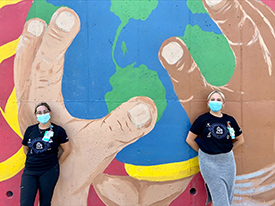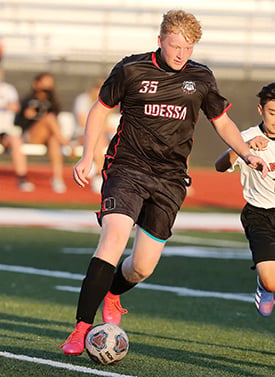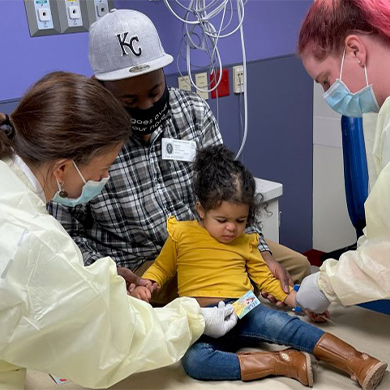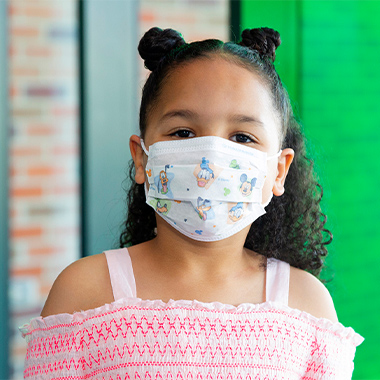Jennifer E. Schuster, MD, MSCI
Associate Program Director, Infectious Diseases Fellowship; Professor of Pediatrics, University of Missouri-Kansas City School of Medicine; Education Assistant Professor of Pediatrics, University of Kansas School of Medicine
Full BiographyCreating a research study in the middle of a pandemic is no small feat. But thanks to a determined team at the Children’s Mercy Research Institute (CMRI) and a large network of established researchers, several hospitals made it happen.
A study named “Overcoming COVID-19” was developed in the spring of 2020 in conjunction with the Centers for Disease Control and Prevention (CDC). The goal is to evaluate children who require ICU (Intensive Care Unit) hospitalization from either COVID-19 or Multisystem Inflammatory Syndrome in Children (MIS-C).
“Getting research up and going in the middle of a pandemic is incredibly difficult,” said Jennifer Schuster, MD, MSCI, Infectious Diseases. Fortunately, a network of hospitals was already established, led by Boston Children’s Hospital, for the purpose of collecting data for a study on severe, acute influenza requiring intensive care in children. Children’s Mercy was part of that network.
Severe COVID-19 in children: gathering data together
Last spring, when the pandemic was gaining momentum, the network quickly pivoted from severe influenza surveillance in children, to severe COVID-19 surveillance in children.
Most children have mild COVID-19. They weren’t being affected as severely as adults, and rates of hospitalization were lower. “It would have been very challenging to get enough data from just one hospital to start really looking at COVID-19 in children,” said Dr. Schuster. The study included a registry to collect data that included demographics. “We desperately needed data in children to be able to contribute landmark data showing racial and ethnic differences,” she said.
The ability to find innovative ways to keep research going was crucial to the success of the study.
Because hospitals were shut down and unable to do research, having an existing network with infrastructure already in place was a key component to the study. It also required innovative thinking and determination. “The CMRI recognized the need for COVID-19 research early on and was incredibly supportive moving things forward,” said Dr. Schuster. "The ability to find innovative ways to keep research going was crucial to the success of the study.”
Conducting COVID-19 research safely

With the restrictions that were in place, study coordinators had to navigate new processes to perform the research safely. Abby Kietzman, Clinical Trials Coordinator 1, Infectious Diseases, joined the CMRI research team in August of 2020 when researchers were in the early stages of understanding COVID-19 in children. While this meant few children to study, many of the families with hospitalized children were willing to enroll. “They wanted to do anything that helped, anything that can figure this out,” said Abby.
Fellow coordinator Shannon Hill, RN, BSN, Clinical Research Coordinator 1, Infectious Diseases, joined the study in October of 2020. Coordinators could not interact with patients and families in person, so an over-the-phone consent process was implemented. Abby and Shannon would work with nursing staff to get blood samples and relay information to families. “This is where the floor nurses were vital to the study,” said Abby. “The nursing staff was really important in making sure these families understood that we are trying to find out what is going on with their kids,” she said.
Many of the children in the study experienced lengthy hospital stays. Abby and Shannon were constantly collecting information and processing data for the study. “Kids are here for weeks on end or a month or two, so you end up with pages and pages of information,” said Shannon.
The study is very data intensive, with each subject requiring hours of work. “That was the bulk of the project,” said Shannon, adding that they would spend weeks at a time processing all the information. “At one point, we were so behind because we were enrolling so quickly that we had to take two weeks off from everything just to catch up on data,” said Abby.
The data are reviewed by investigators at Boston Children’s Hospital (the lead site) and the CDC (the sponsor). The network’s collective research has already made an impact. Several papers, including in the Journal of the American Medical Association (JAMA) and in the New England Journal of Medicine have been published, in addition to a New York Times article. “We were very proud to get into JAMA,” said Shannon, who shared the publications with families, reminding them that they’ve contributed to the research. “That’s an amazing thing to say to a 10-year-old,” she said.
Understanding MIS-C
As the pandemic continued, eligibility criteria for the study changed. “Over time, we started seeing that it was more MIS-C and less acute COVID,” that was causing severe illness in children, said Abby. As this trend continued, the CDC asked researchers to focus on kids with MIS-C.
A common theme for children in the ICU hospitalized for MIS-C is asymptomatic COVID-19. Often, the child won’t even know they’ve had COVID-19 until several weeks later, when they become severely ill with MIS-C. Once admitted and diagnosed with MIS-C, tests often reveal they are positive for COVID-19 antibodies.

That was the case for 17-year-old Alexander Armstrong, who was admitted last October. The month prior he was exposed to COVID-19 through his soccer team and developed some mild symptoms. It wasn’t until several weeks later that he developed a high fever. He got a COVID-19 test, but it came back negative. Within the next few days, the fever persisted, and Alexander began vomiting and complaining of severe pain in his right side. His family took him to Children’s Mercy.
“We were convinced it was appendicitis,” said Alexander’s father, Daniel Armstrong. Lab tests discovered COVID-19 antibodies, dilated coronary arteries, elevated liver and pancreatic enzymes and other markers that led to a diagnosis of MIS-C. “We were caught off guard,” said Daniel, who immediately started researching COVID-19 cases in children and teens and discovering just how serious MIS-C could be. Daniel agreed to enroll Alexander in the study. Like many families, they wanted to do anything to help.
“It was scary for us,” said Daniel, acknowledging that it could have been much worse. Alexander was released after five days and has no lingering aftereffects. The experience strengthened the family’s perspective on COVID-19 precautions. “It reinforced my resolve to operate in a certain way,” said Daniel, who along with his wife, chose to get the vaccine as soon as they were able to. Alexander, who is headed to Missouri State this fall for his first year of college, recently received his second dose of the vaccine.
Like Alexander, most of the children in the study have fully recovered and many of them are also eligible for the vaccine. “Overall, we’ve learned that most children do go on to recover and are discharged,” said Dr. Schuster.
The future of COVID-19 pediatric research
The demographic information collected in the study showed that children who are Black, Hispanic or Latino are at higher risk for hospitalization. Obesity is also a significant risk factor. “Last summer, we really focused on just describing what it looked like,” said Dr. Shuster. “Now, we can ask more complex questions,” she said, noting that research is now more focused on a deeper understanding of who is at risk and what can be done to prevent and treat COVID-19 in children.
The study is still enrolling children and continues to evolve. “Hopefully, there are less children to enroll,” said Dr. Schuster. “Infectious disease docs don’t mind being put out of business.”



